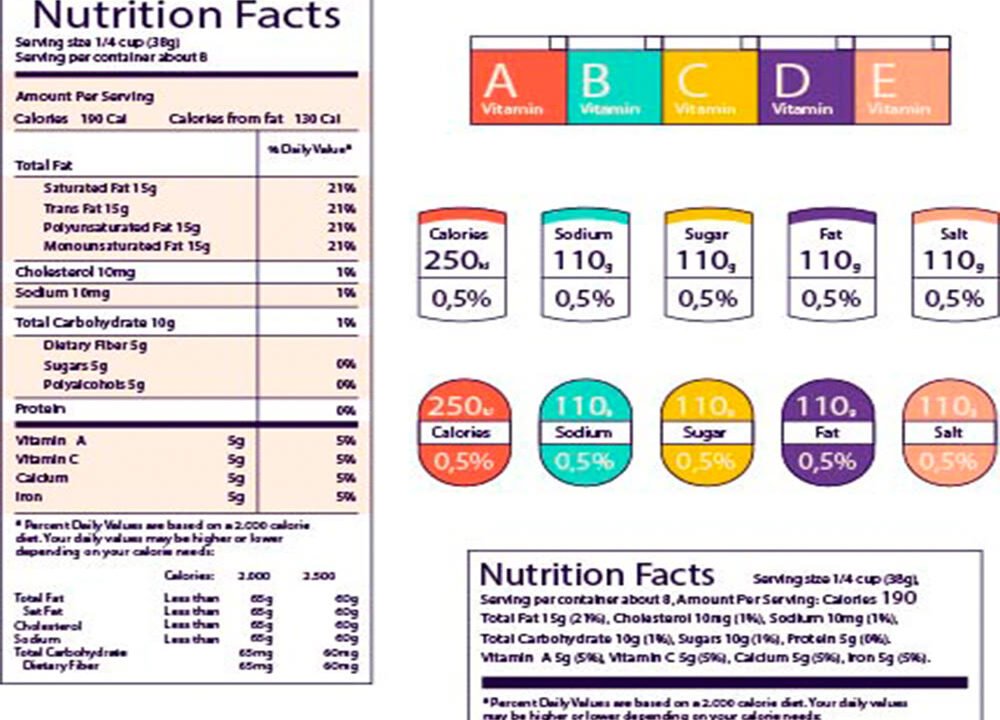We often see the nutritional facts label on products, but have we ever wondered why this nutrition fact label is applied?
If you have noticed, you must have seen that it provides us with some important health-related information, which helps us understand how we should eat to keep our bodies healthy and avoid any harm.
To know more about this important health-related information and to keep your health in mind, read it completely and take care of your diet.
What are Nutrition Facts Labels?
Nutrition labels are essential tools that help consumers choose healthier foods. They display serving sizes, calories, and the percentage of daily values (%DV) for various nutrients, helping you determine if a food item is high or low in a particular nutrient.
- Fat: Certain fats, like saturated fats, can increase heart disease risk, while others (like unsaturated fats) promote heart health.
- Cholesterol & Sodium: Too much cholesterol and sodium can harm heart health.
- Carbohydrates: Carbs provide energy, but excessive sugars can be harmful.
- Protein: Crucial for tissue repair and muscle growth.
- Vitamins & Minerals: Essential for various bodily functions, keeping you healthy.
By reading labels, you can select foods that support your health goals.
Unhealthy Nutrients
When it comes to nutrition, it’s essential to be mindful of the nutrients we consume. While some nutrients are necessary for our well-being, others can have harmful effects on our health when consumed in excess. Let’s explore the impact of various unhealthy nutrients
Cholesterol:
Cholesterol is a type of fat found in animal-based foods like meat, poultry, and dairy products. While our bodies need cholesterol for essential functions, consuming too much can lead to a buildup of plaque in the arteries, increasing the risk of heart disease and stroke. It’s recommended to limit cholesterol intake to less than 300 milligrams per day, with an even lower limit for individuals with heart conditions.
Saturated Fat:
Saturated fat is another type of fat that can raise levels of LDL cholesterol (the “bad” cholesterol) in the blood, increasing the risk of heart disease and stroke. Sources of saturated fat include red meat, butter, cheese, and processed foods. The dietary guideline advises limiting saturated fat intake to less than 20 grams per day to maintain heart health.
Added Sugars:
Added sugars are sugars and syrups added to foods and beverages during processing or preparation. They contribute to empty calories without providing essential nutrients. Excessive consumption of added sugars is linked to obesity, type 2 diabetes, heart disease, and dental cavities. It’s recommended to limit added sugar intake to less than 10% of daily calories.
Sodium:
Sodium is a mineral found in salt and is often added to foods for flavor and preservation. High sodium intake is associated with high blood pressure, heart disease, stroke, and kidney damage. It’s essential to limit sodium intake to less than 2,300 milligrams per day, with an even lower limit for certain individuals.
Refined Grains:
Refined grains have been processed to remove the bran and germ, stripping away essential nutrients and fiber. They include foods like white bread, white rice, and refined pasta. Consuming too many refined grains can lead to weight gain, insulin resistance, and an increased risk of type 2 diabetes and heart disease.
Healthy Nutrients
Fiber: Fiber is a type of carbohydrate found in plant-based foods that cannot be digested by the body. It helps regulate digestion, promotes satiety, and contributes to heart health by lowering cholesterol levels. Whole grains, fruits, vegetables, legumes, nuts, and seeds are excellent sources of fiber.
Healthy Fats: Healthy fats, such as monounsaturated and polyunsaturated fats, are essential for brain function, hormone production, and nutrient absorption. They also provide long-lasting energy and promote heart health by reducing LDL cholesterol levels. Sources of healthy fats include avocados, olive oil, nuts, seeds, and fatty fish like salmon and trout.
Antioxidants: Antioxidants are compounds that help neutralize harmful free radicals in the body, reducing the risk of chronic diseases and promoting cellular health. They are found in colorful fruits and vegetables, such as berries, spinach, kale, and tomatoes, as well as in nuts, seeds, and certain spices like turmeric.
Vitamins and Minerals: Vitamins and minerals are essential micronutrients that support various bodily functions. Key vitamins include vitamin A, which promotes healthy vision and immune function, and vitamin C, known for its antioxidant properties and role in collagen production. Calcium and iron are crucial minerals for bone health and oxygen transport in the blood, respectively. Additionally, vitamin D and potassium play important roles in maintaining overall health. It’s important to consult with a healthcare professional to determine your specific vitamin and mineral needs. In some cases, adjustments may be necessary to balance nutrient intake, such as reducing potassium-rich foods if levels are too high.
Omega-3 Fatty Acids: Omega-3 fatty acids are essential fats that provide numerous health benefits, including reducing inflammation, supporting heart health, and promoting brain function. Sources of omega-3s include fatty fish like salmon, flaxseeds, chia seeds, and walnuts. Incorporating these foods into your diet can contribute to overall well-being.
Nutrition Facts Levels Explained
High-Level Foods: These foods are full of the good stuff our bodies love. Picture vibrant fruits and veggies, whole grains, lean proteins such as chicken and fish, and healthy fats like avocados and nuts. Make sure to have these foods often to keep your body happy and healthy.
Moderate-Level Foods: These foods give us a little bit of good stuff, but they can also have things like extra sugar, bad fats, or processed carbs. Think of packaged snacks, processed meats, and sugary drinks. It’s okay to have them sometimes, but don’t overdo it. Just have them in small amounts as part of a balanced diet.
Low-Level Foods: These foods don’t give us much good stuff and can even be bad for our health if we eat too much of them. Think of sugary treats, fried foods, and super processed snacks. Try not to have them a lot to help your overall health.
Understanding the Cross Symbol
The cross symbol referring to is commonly known as the “plus sign.” It’s often used on nutritional facts labels to indicate that a particular nutrient is present in a significant amount in the product. This symbol doesn’t necessarily mean that the nutrient is beneficial or essential for health, but rather that it’s present in notable quantities. For example, you might see a plus sign next to nutrients like protein, fiber, or certain vitamins and minerals. It’s a quick way for consumers to identify key nutritional components in a product.
The plus symbol (†) next to some nutrients on food labels means the numbers are shown as percentages of what you need each day (DV), not as exact amounts like grams or milligrams. It tells you how much of your daily requirement for that nutrient is in the serving size listed. This helps you compare values between products because it shows proportions instead of exact amounts.
Understanding Daily Values
These values are really helpful for checking if a food is healthy and for making good choices about what to eat.
They act as checkpoints to see if we’re getting enough of the good stuff and not too much of the not-so-good stuff.
Daily Values are usually shown as percentages, telling you how much of your daily limit for that nutrient is in one serving of a food.
For example, if a food has a Daily Value of 10% for saturated fat, it means one serving gives you 10% of what’s recommended for how much saturated fat you should have in a day.
Cross Symbol and Allergen Risks
When there’s a cross symbol on a food product, it could mean it was made using equipment that touches allergens. This might cause cross-contamination, even with strict safety rules in place.
Accidental mixing of ingredients during production can be risky for people with severe allergies. Even tiny traces of allergens can cause bad reactions. Even though they try hard to stop it, there’s still a little chance that allergens could end up in the food. This is a big concern for people with serious allergies who have to stay away from even tiny mark of allergens.
Practical Implications
Easier for Comparisons: The cross symbol on nutrition facts labels helps you compare nutrients in different products, making it easier to see how they fit into your daily nutrient goals.
Making Smart Choices: Knowing what the cross symbol means and understanding DV percentages helps you make better decisions about what you eat. It lets you aim for a balanced, healthy diet. Remember to think about your own dietary needs, health goals, and lifestyle when you look at nutrition info and plan your meals.
FAQs: Understanding the Cross Symbol on Nutrition Labels
The cross symbol on a nutrition label shows the reference amount customarily consumed (RACC). It’s like the FDA’s standard serving size for figuring out the nutrition facts.
How does the cross symbol help consumers?
The cross symbol helps consumers understand the standard serving size and compare different products easily based on their nutritional value.
How do I understand nutrition labels?
Check the serving size first, and servings per container. Then, look at calories, carbs, protein, and fat. Don’t forget vitamins and minerals. %DV tells you how much each nutrient contributes to your daily needs.
How do I make healthier choices using the cross symbol?
Look for lower saturated fats, added sugars, and sodium, and more fiber, vitamins, and minerals. The cross helps pick more balanced foods.
How does the cross symbol impact food choices?
The cross symbol is important for people with allergies or specific diets. It helps them steer clear of foods that might cause problems, showing possible cross-contamination.





